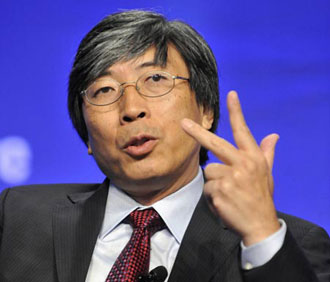The richest man in Los Angeles surfed his way to wealth. Not so much the surfing he does with his actress wife and two kids at the beach, but the pipelines he’s ridden in a rapidly changing healthcare industry.
Patrick Soon-Shiong’s estimated $7 billion fortune owes to a gift for skillfully positioning himself to ride trends that swell into huge opportunities for gain while staring down choppy seas that would have shattered lesser riders into flotsam.
The mental toughness Soon-Shiong developed growing up “colored” under South Africa’s apartheid system helped him thrive in a biotech field that has treated him harshly at times. He has faced suicide by the patient whose remission from diabetes gave Soon-Shiong his first big success, a fraud suit by his own brother, accusations of self-dealing by the investment community and the authorities, attacks on his claims for the efficacy of supposed wonder drugs. It all culminated in two multi-billion-dollar paydays.
While winning many admirers for his generosity Soon-Shiong has also incurred the resentment of neighbors by snapping up a block of ordinary homes, tearing them down and combining them into a 3-acre pad for a mega-mansion to share with his actress wife and two children. As if that isn’t obnoxious enough, he has also recently bought a chunk of the L.A. Lakers and uses it to put a full-court press on key business prospects.
And at the age of 58 Soon-Shiong isn’t about to paddle into the sunset with his estimated seven billion dollar fortune. Instead, in early February he has plunked down a chunk of it on a company that could offer him yet another chance to ride the wireless healthcare pipeline to the biggest payday of his career.
Patrick Soon-Shiong was born in 1952 in Port Elizabeth, South Africa to immigrant parents who had fled China during World War II. The family had come from Taishan County, a strategic coastal region about 20 miles southwest of the city of Guangzhou in Guangdong Province. Taishanese have been the most prominent group of overseas Chinese since a large-scale exodus began in the early 1800s triggered by natural disasters and the colonization that followed China’s defeat to Britain in the First Opium War (1839-1842). The Japanese invasion a century later triggered another wave of emigration from Taishan. Among them were the Soon-Shiong family (originally surnamed Wong). Emigration from Taishan was so heavy that by the mid 20th century about 75% of all Chinese Americans traced their origin to that region.
Patrick’s father had been an herbalist in China. In South Africa the elder Soon-Shiong continued to practice herbal medicine though his main source of income was the family’s general store.
“My father was a village doctor, practicing Chinese herbal medicine,” Patrick told an interviewer from Los Angeles Business Journal in October of 2008. “People would come to the house for advice. He’d make up some herbal concoction to give them. I’d watch all that. It was very inspiring and influences what I do today.”
Patrick’s ambitions faced barriers imposed by South Africa’s apartheid system under which Chinese were legally second-class citizens. Only toward the latter part of the 1970s, after South Africa established diplomatic relations with Taiwan, Japan and South Korea, were some Asians accorded “honorary white” status. Even so non-whites had no hope of being admitted to medical school without exceptional qualifications. Patrick graduated from high school at age 16 with good enough grades to win acceptance to the University of Witwatersrand Medical School. Next


